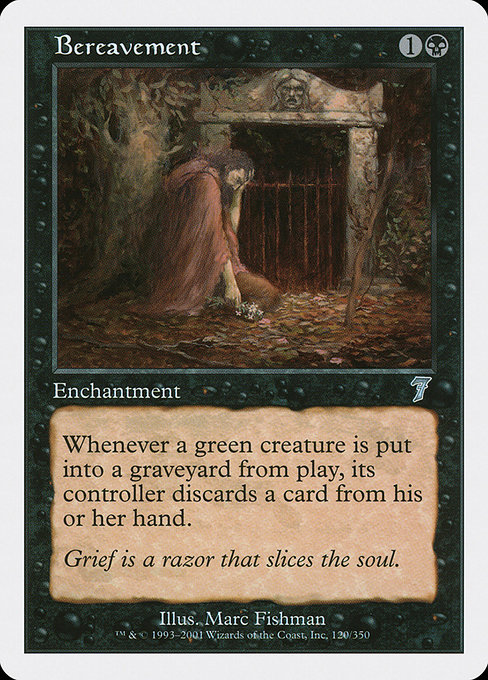Autumn is a heavy time for me. The beauty and the decay merge in nature through the dying plants and flowers and changing leaves and the mornings leak light slowly, almost holding the darkness in. It’s what I think black cards usually look and feel like. Woe, madness, chill. Rot, expulsion, decay. My mother died in an October some years ago. She was buried on her wedding anniversary. If that’s not woe, I don’t know what is.

But for all that grim-mouthed seasonal despair, there’s still what’s yet to be buried. And if you’re here reading this, then it’s likely because of games, card games, and Magic. There’s nothing more comforting in my mind then playing a game with friends inside where it’s low-lit and warm and outside the rain is misting and the wind is gusting. The clouds are slatey and bulbous. Someone is wearing a heavy metal t-shirt. I’ve told the story before that my first memory of seeing a Magic card was a land. And no kidding, it was a Swamp (Swear). The skull on the bottom half of the card is inscribed in my mental circuits. The idea of “adding” a skull to a “mana pool” was so abstract. I was put off by the card. Because I watched someone tap it. That was so mystical to me. In all the games I’d played, there was no reason to turn a card on purpose. Simple, yet effective. I can’t remember what set the Swamp was from (the timing could be Portal?), but the picture of the landscape was enough to irk me.


I’ve always lived next to rivers and swampy areas, so maybe these landscapes scratched a deep itch in me. And maybe because of this, and the morose shifting of the weather and emotional tides, I wondered: what’s the saddest Magic card out there? Unsurprisingly, when I searched around, this question has been lobbed around a bit on forums. (Surprisingly, lots of Aether Revolt cards mentioned.) Words like “saddest” or “most depressing” are subjective, of course. But I wanted to find the black non-land equivalent of that first Swamp I spied. What could match that moldering loneliness of the marshes?
There is a case to be made for Exiled Boggart. Among the boggarts, there is only one real rule: all new treasures and experiences must be shared. Those who hoard their gifts commit the one truly unforgivable sin.

The flavor text matches so well with the Pete Venters art. The depression of the boggart, his droopy limbs almost washed away by the creek water. I would propose that the art is so sad because the expression of the boggart is one of knowingness. He recognizes his mistake and regrets it. However, it is too late. His exile is irreversible.
I also recently found, and enjoy, Melancholy from Planar Chaos.

Something about the loneliness of these characters strikes me as, well, melancholy. Especially since this giant has decided to sit on a farmer’s barn while he pouts. And the clouds double as a seething mist of gloom above his head–created by the giant or a happenstance, we don’t know. But the blacks and browns in this painting by Lars Grant-West mix into a lurid greenish color between the horizon and the clouds. It is an ill light and stagnant. Perfect weather for melancholy.
We can return to the Lorwyn universe with Pack’s Disdain, also by Pete Venters. Another perfect match of flavor text and imagery. Like the sun to a flower, the adoring gaze of the tribe is sustenance to an elf. To be shunned is to wither. What we’re bristling against here again and again is loneliness. Abandonment. Separation from the community, the gathering. What makes the Venters image so powerful isn’t necessarily the grieving elf in the grass, but the sentinel wall in the distance created to keep a living border between him and the rest of society.
I am leaning toward a rather classic image, though. That of Beareavement from Seventh Edition.

The art by Marc Fishman goes hard because it doesn’t pull punches. A man grieves at a crypt. It is autumn. He is wan, disheveled. His gesture of flowers is fallen and insufficient to meet the moment. All he can do is fall to his knees in grief and mourn. I nominate this one because there’s nothing supernatural or monstrous about it. One thing black cards don’t do a lot of, even though they deal with death, is mourning and the loss that comes with the darkness it promotes. Yes, characters in those cards are often thrilled to be dead or kill someone. Darkness is happiness to them. But I want to argue that what makes a card powerful–emotionally, pictorially, conceptually–often is the closeness to our human reality. Which is why lots of the card suggested in the forums were those that centered around everyday human images/figures. Children, dogs, small toys. And the loss of those said objects, people, ideas.
I’ve started to pay more attention to the Swamps I play when I build my decks. Not because of aesthetic uniformity, but because, somewhere, deep down, I want that small wince of yearning that the art can produce. I sometimes want that October of the soul in the October of the world.
Kyle Winkler (he/him) is a teacher and fiction writer. While he was pre-teen when Magic: The Gathering was released, he didn’t start playing until recently. He’s the author of the cosmic horror novella (The Nothing That Is), a collection of short stories (OH PAIN), and a novel (Boris Says the Words). His favorite card is a toss up between Crypt Rats and Oubliette.

